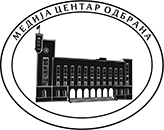08.11.2016
Exhibition "Bombing of Belgrade University in 1914" opens
 CLICK FOR VIRTUAL TOUR !
CLICK FOR VIRTUAL TOUR !  It has long been known that barbarism of war implies the destruction of cultural monuments and educational centres. The exhibition on the bombing of the Captain Miša's building, which has been and remained the central building of the Belgrade High School, then the Lyceum and in the end the University, which has been opened today in the Small Gallery of the Central Military Club, shows exactly such a less known detail from the history of the First World War. Pointing out that this is another in a series of events by which Odbrana Media Centre marks the centenary of the Great War, Lieutenant Colonel Zoran Krupež from the Media Centre pointed out that it was even hard to list everything that was destroyed during that time of great suffering: "What adds importance to these photographs is that each of them tells a thousand words, and that whole exhibition, in one place, shows the destruction of the University. "
It has long been known that barbarism of war implies the destruction of cultural monuments and educational centres. The exhibition on the bombing of the Captain Miša's building, which has been and remained the central building of the Belgrade High School, then the Lyceum and in the end the University, which has been opened today in the Small Gallery of the Central Military Club, shows exactly such a less known detail from the history of the First World War. Pointing out that this is another in a series of events by which Odbrana Media Centre marks the centenary of the Great War, Lieutenant Colonel Zoran Krupež from the Media Centre pointed out that it was even hard to list everything that was destroyed during that time of great suffering: "What adds importance to these photographs is that each of them tells a thousand words, and that whole exhibition, in one place, shows the destruction of the University. "Božidar Zejak, director of the Pedagogical Museum, explained that this is the third appearance of the exhibition before the audience: "It was for the first time two years ago that it was displayed in Negotin. For the Serbian spirituality, destruction and suffering has already become a tradition, as evidenced by the burning of the relics of St. Sava at Vracar and the remains of the National Library at Kosančićev venac."
 Branislava Jordanović from the Pedagogical Museum, author of the exhibition, stressed the importance of Dr. Djordje Stanojević, the then Rector of the University. "Djordje Stanojević, whom we regard the originator of the artistic photography in Serbia, recorded that Captain Misa's building, that is University, as one of the highest buildings in the then Belgrade was bombed the first night of the war and that it was a regular target. Photos he had taken he sent to Paris, where they were first published by the newspaper "Liberation", and then, with the help of the director of the Directorate for Education, Lucien Poincaré, brother of a famous politician, published in a special book, in 1915."
Branislava Jordanović from the Pedagogical Museum, author of the exhibition, stressed the importance of Dr. Djordje Stanojević, the then Rector of the University. "Djordje Stanojević, whom we regard the originator of the artistic photography in Serbia, recorded that Captain Misa's building, that is University, as one of the highest buildings in the then Belgrade was bombed the first night of the war and that it was a regular target. Photos he had taken he sent to Paris, where they were first published by the newspaper "Liberation", and then, with the help of the director of the Directorate for Education, Lucien Poincaré, brother of a famous politician, published in a special book, in 1915." Vladimir Bumbaširević, Rector of the Belgrade University, said that no country that participated in that armed conflict paid for its freedom so dearly as Serbia did. "Therefore this is the right time for Belgrade to see this exhibition", Bumbaširević said. Briefly recalling the development of higher education in our country since the Great School to date, Bumbaširević mentioned what Djordje Stanojevic, the scientist responsible for the electrification of Serbia, wrote about the destruction of the University – as a visible target, it was targeted every day, and the difference was only in projectile calibre size.
Vladimir Bumbaširević, Rector of the Belgrade University, said that no country that participated in that armed conflict paid for its freedom so dearly as Serbia did. "Therefore this is the right time for Belgrade to see this exhibition", Bumbaširević said. Briefly recalling the development of higher education in our country since the Great School to date, Bumbaširević mentioned what Djordje Stanojevic, the scientist responsible for the electrification of Serbia, wrote about the destruction of the University – as a visible target, it was targeted every day, and the difference was only in projectile calibre size.The exhibition that can be seen in the Central Military Club until 26th November, was organised in cooperation with the Pedagogical Museum, the most credited with the research which resulted in this cultural event, and with the Chemical Faculty that singled out from its historical collections and borrowed an old laboratory artefacts for the exhibition to be more complete.
 PHOTOGALLERY
PHOTOGALLERY
